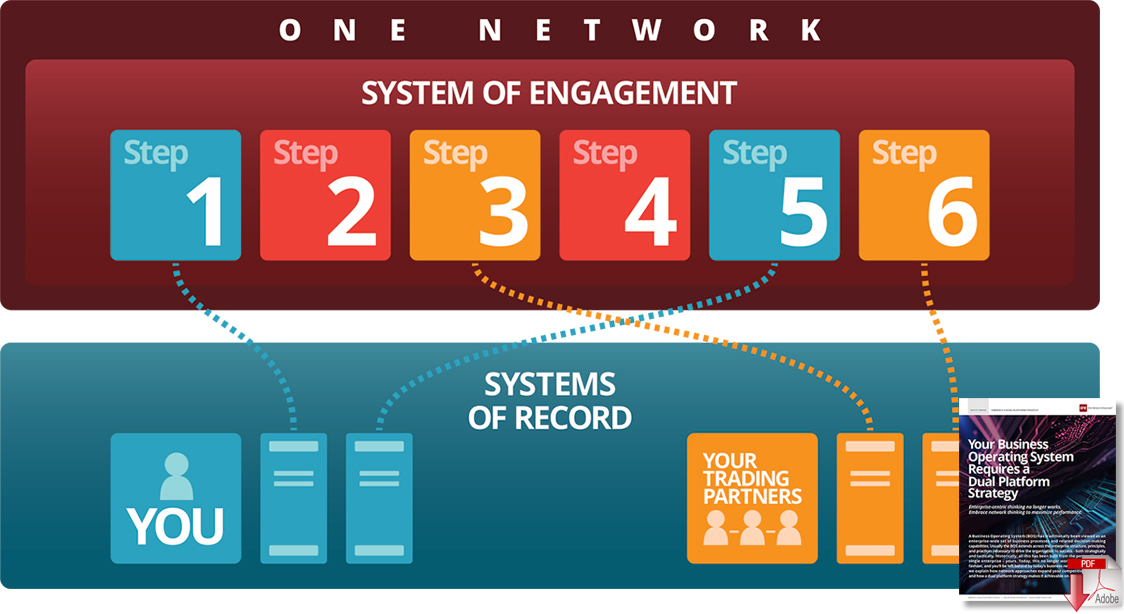Why Your Business System Requires a Dual Platform Strategy to Optimize Your Supply Chain Network

The purpose of a dual platform digital twin strategy is to analyze business questions like improving node-to-node movements across your supply network or driving policies that improve the customer experience and solve all the problems that present themselves across your supply network.
Optimize Your IT Investment While Leveraging the Latest Technology
Companies need to upgrade their business systems and take advantage of the latest technology.
The problem is that companies have invested millions of dollars in Enterprise Resource Planning (ERP) and other legacy systems, many of which are contributing value to the organization, so it doesn’t make sense to disrupt their business with a major “rip and replace” effort.
The solution is a dual-platform strategy that embraces and enhances the current system, while tying all systems together and supplementing them with the powerful new functionality that is available today, such as real-time visibility, intelligent agent technology, and blockchain.
One Network’s Real Time Value Network (RTVN) embraces legacy systems (your own and your trading partners), and incorporates the data and processes into the network, giving you control over how complex multiparty processes are managed across companies and systems.
This means that companies can fully recoup their investments in ERP and legacy systems while enhancing business processes with the RTVN. And all without a high risk, low value “big bang” implementation.
How the Dual Platform Strategy Works
The multi-party dual-platform strategy involves a phased approach to migrating legacy applications into a unified Platform.
The RTVN’s Tunable System of Control provides an easy visual interface that coordinates and delegates full processes (or individual steps in processes) to the appropriate system of record.
Here’s how it works.
Step 1: Introducing the Multiparty Transactional Platform
The multi-party transactional platform is introduced as an orchestration and visibility layer between systems. Thanks to its extensive system integration capabilities and flexible data model, the Platform can act as an ESB (Enterprise Service Bus) to connect existing apps.
But beyond the capability of typical ESB’s, the platform also stores the data that flows through in its own extensible semantic model. This provides visibility, alerting, and other analytics across those legacy systems as part of the first step of the “embrace” approach.
The Tunable System of Control: Embracing and Coordinating Network and Legacy Systems
Step 2: Turn On Modules for Legacy Functionality on the Platform
The platform begins subsuming legacy systems using a combination of its existing commercial modules, along with customization models developed and deployed using the SDK. The platform has an extensive set of commercial modules covering many business domains, including order management, transportation, warehouse management, and financials. Using these as a foundation, additional modules can be developed using the SDK to fill functional gaps unique to legacy systems. Once these modules are developed, they can then be deployed on the platform.
Modules running on the platform have the advantages of a shared data model, shared functional capabilities, modern technology, and more versus their legacy origins.
Step 3: Switch from Legacy to Network Apps
The Tunable System of Control on the RTVN allows you to easily delegate the system of record for a process. Once the functionality is enabled on the network, a simple UI enables you to switch the functionality to the network app, disengaging the legacy app from the process. The changeover is really “push button” simple and seamless.
This makes it very easy to phase in the migration of these systems onto the platform (or even parts of those systems), as parts of the platform’s business flows can be declaratively enabled/disabled through visual tools and delegated to other systems.
That’s it. With the Real-Time Value Network and the Tunable System of Control, you don’t need to choose between legacy or the latest technology; you can use both. You can enjoy a rapid and seamless transition to a digital platform while remaining in full control of existing systems and extracting value.
WEBCAST How to Optimize Your Supply Chain with a Digital Twin
Date: Thursday, July 16, 2020 | Time: 12:00 PM EDT / 9:00 AM PDT
Apply prescriptive analytics to help you deliver the highest possible service levels at the lowest cost.
The point of a digital twin is to analyze business questions - like improving node-to-node movements across your supply network, or driving policies that improve the customer experience and solve all the problems that present themselves across your supply network.
In this Webcast, we’ll explain why your digital twin needs to be a sandbox extension of your planning and operations platform – one that applies different statistical, machine learning, and AI algorithms along with various workflow options to solve problems.
If your planning/operations platform and the digital twin are one and the same system, you’ll be able to evaluate choices based on the top algorithms in the market, and then make those choices actionable in real-time. They can be strategic in nature, based on network design options that will benefit you two years from now, or can fix a problem that is expected to occur in the next few hours. Sound too good to be true? We’ll explain how.
One Network Enterprises is a leader in supply chain planning, execution, and digitization, so join COO Joe Bellini for insights on how to optimize performance, gain resilience, manage costs through thick and thin, and protect revenue growth with a digital twin strategy.

Article Topics
One Network Enterprises News & Resources
Blue Yonder announces an agreement to acquire One Network Enterprises for $839 million Blue Yonder Acquires One Network Enterprises for $839M Companies Need to Develop New Innovative Approaches to Supply Chain Design How to Improve Cost of Goods Sold Horizontally Across the Supply Chain How the Global Pandemic Accelerated Supply Chain Visibility, Digitalization, and Automation AI and Data, the Future of Supply Chain Management AI and Supply Chain Problem Solving More One Network EnterprisesLatest in Supply Chain
Why Grocery Shoppers are Leaving Stores and Buying Their Food Online Is There a Next Generation of Truckers? Data Reveals Grim Outlook A Look at Baltimore’s Key Bridge Collapse—One Month Later European Parliament Passes Law on Supply Chain Accountability Baltimore Continues Bridge Recovery With Opening of New Channel How Shippers Can Prep for Hurricane Season Apple Accused of Multiple Human Rights Violations More Supply Chain















